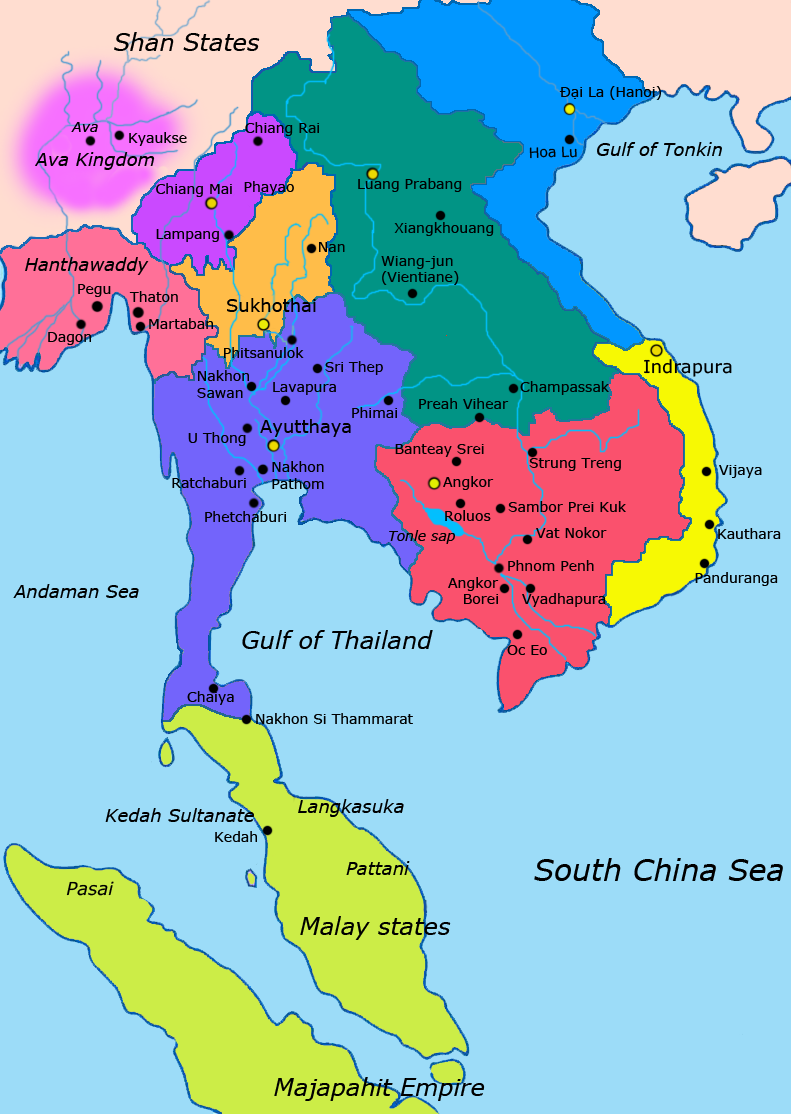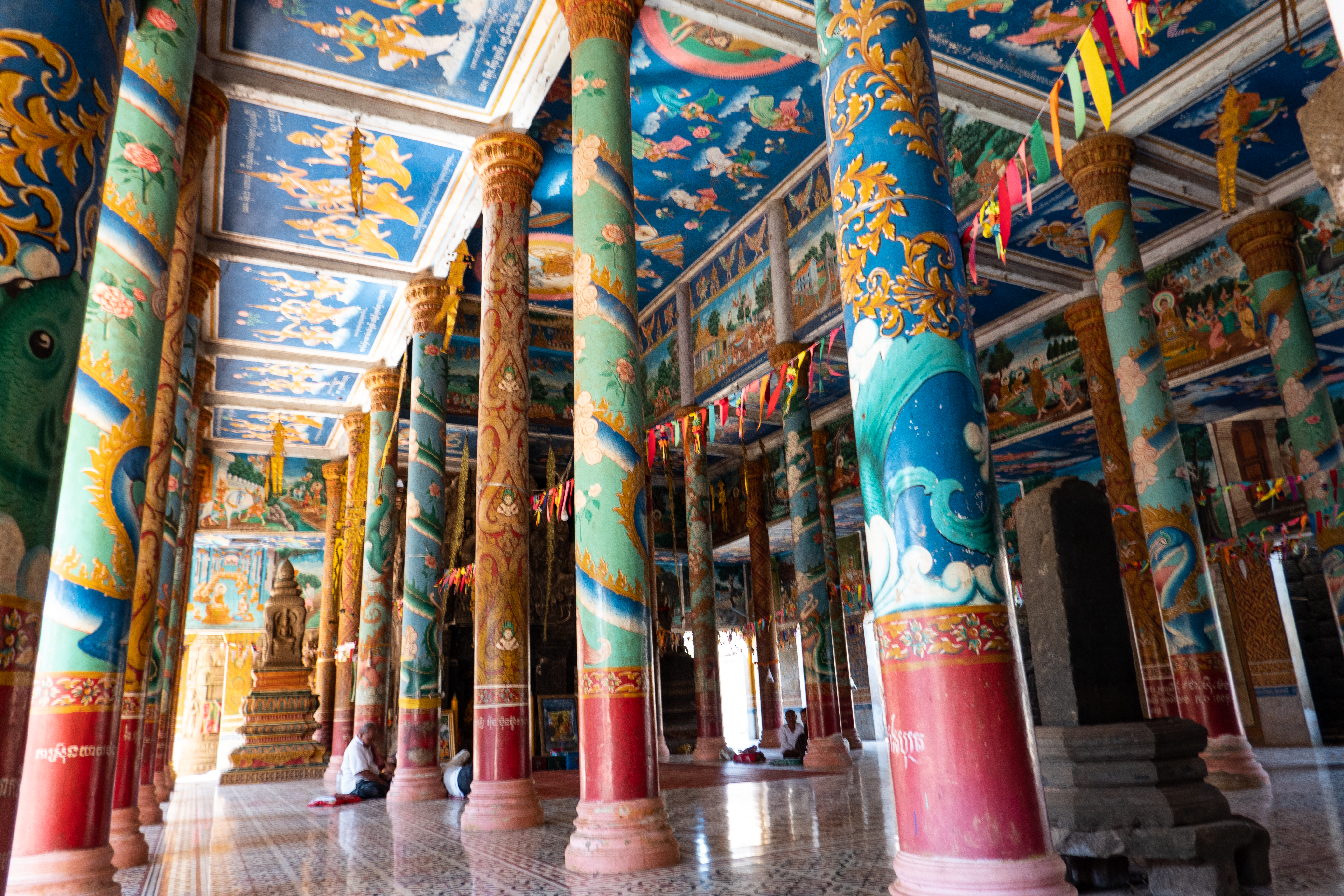|
Dam Din
Dam Din ( km, ដាំដី), also known as Chao Ponhea Techo Chrek Dey or Techo Dam Din, or the underground-traveling Khmer, is a legendary figure from Khmer history, usually described as the general who opposed Phra Ruang who wanted to establish the first Thai kingdom free from the rule of the ancient Khmer Empire. Origins The story of Techo Dam Din originates from some versions of the Thai legend of Phra Ruang; the earliest known written account that mentions the figure is found in the Northern Chronicles compiled by Phra Wichianpricha (Noi) in 1807. The document refers to the figure as ''Khom dam din'' ('earth-diving Khmer'), and makes no mention of the name Techo. Khmer versions of the tale are found in the Cambodian Royal Chronicles; it is not known from Khmer folktales. The earliest known mention is found in the chronicle of Vatt Kok Kak, which was compiled in 1869 during the reign of King Norodom, and several later versions reproduce or build upon the story. The ... [...More Info...] [...Related Items...] OR: [Wikipedia] [Google] [Baidu] |
Memorial Of Phra Ruang And Khom Dam Din
A memorial is an object or place which serves as a focus for the memory or the commemoration of something, usually an influential, deceased person or a historical, tragic event. Popular forms of memorials include landmark objects or works of art such as sculptures, statues or fountains and parks. Larger memorials may be known as monuments. Types The most common type of memorial is the gravestone or the memorial plaque. Also common are war memorials commemorating those who have died in wars. Memorials in the form of a cross are called intending crosses. Online memorials are often created on websites and social media to allow digital access as an alternative to physical memorials which may not be feasible or easily accessible. When somebody has died, the family may request that a memorial gift (usually money) be given to a designated charity, or that a tree be planted in memory of the person. Those temporary or makeshift memorials are also called grassroots memorials.''Grassroo ... [...More Info...] [...Related Items...] OR: [Wikipedia] [Google] [Baidu] |
Phra Ruang
Phra Ruang ( th, พระร่วง) is a legendary figure from Thai history, usually described as the founder of the first Thai kingdom who freed the people from the rule of the ancient Khmer Empire. It is also found as a title that may have referred to one or more kings of Sukhothai, and is referred to in the title of many works of literature, including the '' Trai Phum Phra Ruang'', a Sukhothai-era religious text describing the Buddhist cosmology. A common version of the Phra Ruang legend is that he was a Thai chieftain of Lavo (Lopburi) with supernatural powers of speech. The Thais had to deliver water to the Khom (Khmer) capital as tax, and Phra Ruang used his powers to make bamboo baskets waterproof so that they could be used to carry the water instead of heavy clay jars. When the Khom king wanted him dead, Phra Ruang escaped and ordained as a monk at Sukhothai. A Khom spy, "diving underground", was sent to find him, but not knowing Phra Ruang's face, inadvertently as ... [...More Info...] [...Related Items...] OR: [Wikipedia] [Google] [Baidu] |
Thai People
Thai people ( th, ชาวไทย; ''endonym''), Central Thai people ( th, คนภาคกลาง, sou, คนใต้, ตามโพร; ''exonym and also domestically'') or Siamese ( th, ชาวสยาม; ''historical exonym and sometimes domestically''), T(h)ai Noi people ( th, ไทยน้อย; ''historical endonym and sometimes domestically''), in a narrow sense, are a Tai ethnic group dominant in Central and Southern Thailand (Siam proper). Part of the larger Tai ethno-linguistic group native to Southeast Asia as well as Southern China and Northeast India, Thais speak the Sukhothai languages ( Central Thai and Southern Thai language), which is classified as part of the Kra–Dai family of languages. The majority of Thais are followers of Theravada Buddhism. As a result of government policy during the 1930s and 1940s resulting in successful forced assimilation of many the various ethno-linguistic groups in the country into the dominant Thai language and ... [...More Info...] [...Related Items...] OR: [Wikipedia] [Google] [Baidu] |
Cambodian Royal Chronicles
The Cambodian Royal Chronicles or Cambodian Chronicles (Rajabansavatar or Rapa Ksatr) are a collection of 18th and 19th century historical manuscripts that focus on the time from around the year 1430 to the beginning of the 16th century. This period of Cambodia's history is considered to be the Middle Periods, as it marks the end of the Khmer Empire. Written sources such as Sanskrit epigraphy become obsolete, beginning in the first half of the 14th century. Even Old Khmer inscriptions are absent until the middle of the 16th century. The last king mentioned in the ancient inscriptions of Angkor is King Jayavarman Parameshwara (or Jayavarma-Paramesvara), who reigned from 1327 to 1336. The manuscripts (Sastra Slek Rit) on palm leaves and bound together in bundles are only short-lived. Surviving texts are copies and in many cases only fragments remain. The chronicles begin in 1796 and last far into the 19th century. Records tackle with the chronology of the kings, foreign affairs, ... [...More Info...] [...Related Items...] OR: [Wikipedia] [Google] [Baidu] |
Norodom
Norodom ( km, នរោត្តម, ; born Ang Voddey ( km, អង្គវតី, ); 3 February 1834 – 24 April 1904) was King of Cambodia from 19 October 1860 to his death on 24 April 1904. He was the eldest son of King Ang Duong and was a half-brother of Prince Si Votha and King Sisowath. He was elected to the throne in 1860 but would not be crowned until 1864 due to the fact that Siam held the royal regalia (the royal crown and other artefacts). In 1863, he signed a treaty with France by which he gave France control over Cambodia's foreign relations in exchange for personal protection against his enemies. The treaty saved Cambodian independence, but French control over Cambodia's internal affairs strengthened continually until the end of his reign (full independence was not restored until 1953). His reign of is the longest in Cambodian history in terms of verifiable exact date. Upon his death, he was succeeded by his half-brother, Sisowath. He is the progenitor of the ... [...More Info...] [...Related Items...] OR: [Wikipedia] [Google] [Baidu] |
Khleang Moeung
Ta Pech, Khleang Moeung or Sena Moeung, or ''Ghlāṃṅ Mīoeṅ'' is a mythical-historical sixteenth century military leader in Cambodia, and a guardian spirit ''neak ta'' whose field of action extends to the entire west of Tonle Sap Lake. Etymology: treasure, strength or center Khleang Moeung has a mixed Khmer and Thai etymology. ''Ghlāṃṅ'' is Khmer for "treasure, keeper for the treasury, storehouse" while ''Mīoeṅ'' is Thai for "municipality, region or country”. Thus, keeper of the local treasury. A similar interpretation is made for the name of Thai national hero Pha Mueang who played a significant role in the founding of the Sukhothai Kingdom, freeing Siam from Khmer rule after the reign of Jayavarman VII in the 13th century. According to another interpretation, ''khlāṃṅ'' is also a Siamese word loaned from the Khmer and can take the acception of “magically strong, having a sacred power” which is in tune with qualities attributed to ''Ghlāṃṅ Mīo ... [...More Info...] [...Related Items...] OR: [Wikipedia] [Google] [Baidu] |
Lavo
Known as "Lavo" during most of its history, Lopburi Province is one of the most important cities in the history of Thailand. The city has a long history, dating back into the prehistory period since the Bronze Age of more than 3,500 years ago. Later, it was influenced by the art and culture of India in the 11th century when it entered the historical era. This first period under the influence of Indian culture was called the Dvaravati Period. Since that time, Lavo has been ruled by the Khmer, coming under the influence of their art and culture, in the 15th century, a time commonly called the Lopburi Period in Thai art history. Eventually, when the Ayutthaya empire was established, Lavo decreased in importance until the reign of King Narai. He had a palace built in Lavo, and each year spent most of his time there. After the time of King Narai, Lavo had been abandoned, until the 19th centuries, King Mongkut (Rama IV) had it restored to be used as an inland royal city. Later, in ... [...More Info...] [...Related Items...] OR: [Wikipedia] [Google] [Baidu] |
Lopburi
Lopburi ( th, ลพบุรี, , ) is the capital city of Lopburi Province in Thailand. It is about northeast of Bangkok. It has a population of 58,000. The town (''thesaban mueang'') covers the whole ''tambon'' Tha Hin and parts of Thale Chup Son of Mueang Lopburi District, a total area of 6.85 km2. Etymology It was originally known as Lavo or Lavapura, meaning "city of Lava" in reference to the ancient South Asian city of Lavapuri (present-day Lahore, Pakistan). History The city has a history dating back to the Dvaravati period more than 1,000 years ago.Higham, C., 2014, ''Early Mainland south-east Asia'', Bangkok: River Books Co., Ltd., According to the ''Northern Chronicles,'' Lavo was founded by Phraya Kalavarnadishraj, who came from Takkasila in 648 CE. According to Thai records, Phraya Kakabatr from Takkasila (it is assumed that the city was Tak or Nakhon Chai Si) set the new era, Chula Sakarat in 638 CE, which was the era used by the Siamese and the ... [...More Info...] [...Related Items...] OR: [Wikipedia] [Google] [Baidu] |
Banteay Prey Nokor
Banteay Prei Nokor ( km, បន្ទាយព្រៃនគរ) is an ancient temple complex in the northwest of Kompong Cham, Cambodia. Known locally as temple of "Wat Nokor in Khum of Kompong Siem", or "Wat Angkor", around 2km from the provincial capital Kampong Cham (city). though a sign at the entrance now officially designates the name of the temple as Nokor Bachey Temple ( km, ប្រាសាទនគរបាជ័យ). Layout The complex faces east at a bearing of 84.5°E, and covers 15ha. the site is composed of an outer rectangular laterite wall approximately 420x370m, an inner wall approximately 100x130m. A large reservoir or Baray ( km, បារាយណ៍) some 950 meters long and 480 meters wide is located 350 meters east of the site. Now abandoned, the reservoir area was used in the mid 20th century as a hippodrome, evidence of which can still be seen by visitors. History The monument was built out of sandstone and laterite, and dates from t ... [...More Info...] [...Related Items...] OR: [Wikipedia] [Google] [Baidu] |
Vajiravudh
Vajiravudh ( th, วชิราวุธ, , 1 January 188126 November 1925) was the sixth monarch of Siam under the Chakri dynasty as Rama VI. He ruled from 23 October 1910 until his death in 1925. King Vajiravudh is best known for his efforts to create and promote Siamese nationalism. His reign was characterized by Siam's movement further towards democracy and minimal participation in World War I. He had keen interests in Siamese history, archaeology, and literature, as well as economics, politics and world affairs, and founded the country's first university, Chulalongkorn University. Education Vajiravudh was born on 1 January 1881 to Chulalongkorn and one of his four queens and half sister Saovabha Phongsri. In 1888, upon coming of age, Vajiravudh received the title ''Krom Khun'' Thep Dvaravati (Prince of Ayutthaya). Prince Vajiravudh was first educated in the royal palace in Thai and English. His full siblings were Bahurada Manimaya, Tribejrutama Dhamrong, Chakrabongse B ... [...More Info...] [...Related Items...] OR: [Wikipedia] [Google] [Baidu] |






